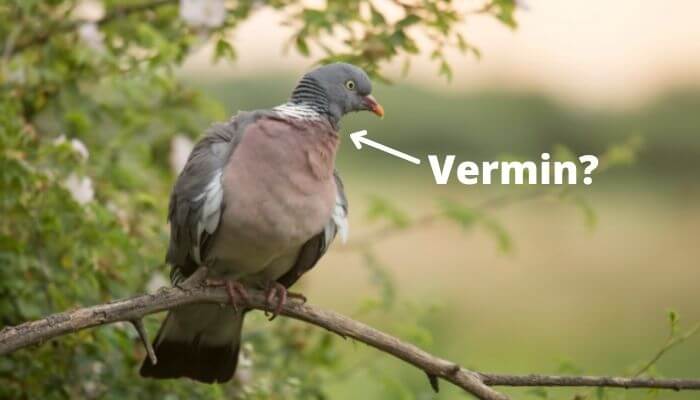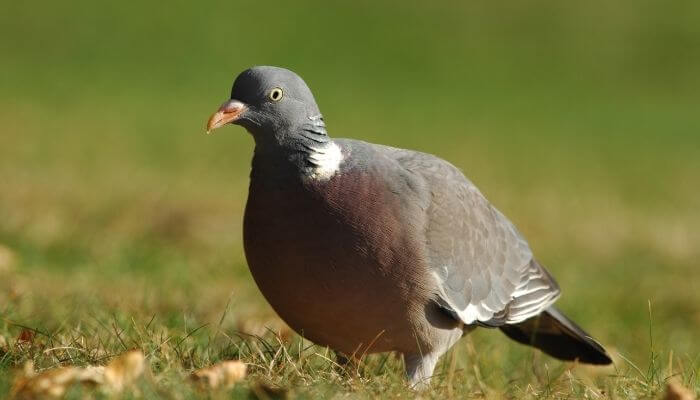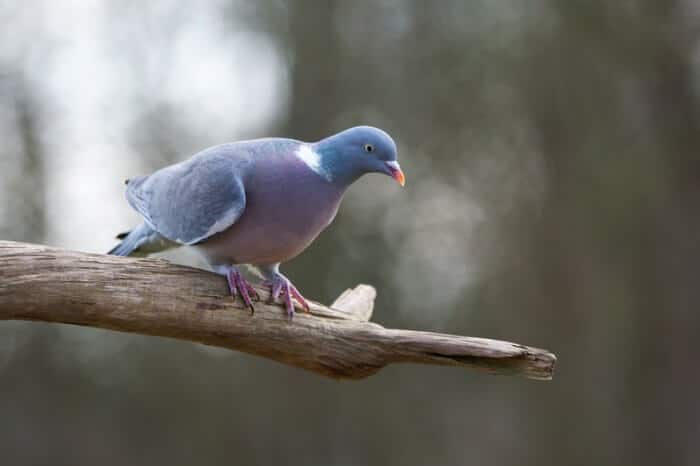Wood pigeons are agricultural pests due to overpopulation, this means they are officially classed as ‘vermin’.

However, there is a long-standing history between man and pigeon which has bought us to a point where we now classify the wood pigeon, who was once so beloved by our ancestors, as vermin.
Are Wood Pigeons Legally Vermin?
If you look at the legal status of pigeons in the UK, then as defined in the Wildlife and Countryside Act of 1981 they have some protection however they are classed as agricultural pests and can therefore be subject to pest control under a general license (GL42).
Vermin is a social term, not a legal term, but essentially, it means the same thing.
The main reason pigeons are called pests or vermin is overpopulation and their impact on agriculture.
Wood Pigeons As An Arable Pest
In the United Kingdom alone, there are as many as 18 million feral and wood pigeons in a relatively small land area.
They are distributed evenly across the whole country, mostly in rural areas but they will also congregate in green spaces in urban areas.

There are numerous natural predators of pigeons but not in sufficient numbers to control the population.
Did you know that it is thought that the population growth of wood pigeons around arable farms is attributed to the huge amount of land that was sown with oilseed rape in the early 1970s?
Wood pigeons feed in flocks and can cause a great amount of damage to oilseed rape and other crops like corn, wheat, peas, and sprouts.
In 2014, a study by The Horticultural Society to look at the damage pigeons caused to arable crops concluded with the estimated cost of £1,250 per hectare, adding up to millions of pounds overall.
This kind of data qualifies the pigeon as an agricultural pest and is, therefore, able to be killed under general license.
Humans vs Pigeons
Man has been waging war on pigeons.
We use all manner of pigeon repellents and deterrents to keep them away from paths, squares, statues, buildings, and rooftops.
We’ve criminalized feeding them, and we trap them, poison them, and shoot them.
We’ve even enforced birth control on them.
Is this level of animosity towards pigeons disproportionate to their crimes?
Especially when there are other pests and nuisance creatures that are more destructive and dangerous.
It is even more puzzling when we know that man and pigeons have lived side by side in towns and cities for thousands of years.

In 2005, a New York sociologist, Colin Jerolmack, extensively studied printed media and anecdotal evidence to identify that our acceptance of pigeons began to hatred in the 1930s and 40s.
The hatred intensified when in the 1950s, it was discovered that pigeons carry and spread diseases.
By the 1960s, various officials marked out pigeons as menaces to be exterminated. It was in 1966 when a New York City Parks Commissioner coined the term “rats with wings”.
This soon went mainstream and since, the pigeons have been explicitly linked to disease and disorder. T
The idea has been baked into the human psyche thanks to it being perpetuated in every media and channel that might influence us.
The pigeon is seen as a blot on the urban landscape. Within the pigeon-fancying community, they are seen as precious and charismatic creatures. So who is right?
Part of the issue is that most of Joe Public don’t know the difference between the most common types of pigeon.
The pigeons that roam our town and city neighborhoods are feral pigeons.
These are similar in looks to the wood pigeon which are mostly found in rural areas.
This similarity has led to both types being tarred with the same brush.
The lack of distinction is not illogical because the ideology was instigated in the USA and in the USA there is no real distinction between the types of wild pigeons unlike in the UK and Europe.
What Is a Wood Pigeon?
The common wood pigeon is the largest and most common pigeon native to the UK, Europe, and Western Asia.
You will be familiar with the wood pigeon as essentially being the ‘stereotypical’ pigeon that comes to mind when asked to imagine the bird.
Grey plumage, rounded bodies, beady eyes, and a red beak with red feet to match.

Wood pigeons have some key identifying features that are a large grey breast, a white patch on their neck, dark wing tips, and white wing patches when in flight.
The main visual difference between the common wood pigeon and the feral pigeon is that wood pigeons are generally fatter because they have a better diet.
Pastoral environments are more food-rich than urban areas.
It is unlikely that the untrained eye can tell the difference between a wood pigeon and a feral pigeon.
The main assumption should be that if you see a pigeon in the countryside, it is likely to be a wood pigeon and if in town, it’s a wild pigeon (feral) pigeon.
Other Reasons
As we’ve already mentioned, the common wood pigeon gets lumped in with feral pigeons when it comes to how pigeons are viewed.
This means that problems caused by one breed are automatically associated with the other.
Wood pigeons get blamed for feral pigeon problems.
- Excessive Droppings
With 18 million pigeons in the air and perching on high up ledges all year round, this inevitably leads to a lot of droppings.
The fact that pigeon poop is white only adds to the poor perception. Pigeon poop is also hard to clean, especially when it is high up on buildings or statues.
- Building Corrosion
The abundance of pigeon droppings is an obvious aesthetic issue, but pigeon poop also causes physical damage.
Poop is very acidic and this can cause deterioration and decay in soft stone and mortar.
- Damage To Property
There is also a wider concern about damage to property that can be caused by pigeons.
This includes the mess and damage that can be done to cars as well as residential buildings.
Because they like to make nests on house roofs, the feathers and nest materials can block up drainpipes and guttering, leading to water damage.
- Carrying Parasites
There are also some health concerns when it comes to wood pigeons being classed as vermin.
They have the potential to carry parasites and fleas that will be effortlessly spread as they move from one location to another.
Some of the common pigeon diseases are easily spread to other creatures and they also carry zoonotic diseases that spread to humans.
Although these issues are associated with (and rightly so) wood pigeons, the impact is to a much lesser extent than feral pigeons.
What we have therefore is clear indication that if you are a farmer there is reasonable justification for seeing wood pigeons as vermin.
If you are however not a farmer, it is feral pigeons you should be more concerned about.
